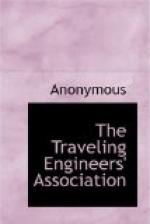THE FEED VALVE AND ITS DEFECTS
99. Q. What do Figures 6 and 7 represent?
A. These are diagrams of the B-6 feed valve in both open and closed positions.
100. Q. Name the different parts of the feed valve.
A. The valve consists of the following parts: 2, valve body; 3, pipe bracket; 5, cap nut; 6, piston spring; 7, piston spring tip; 8, supply valve piston; 9, supply valve; 10, supply valve spring; 11, regulating valve cap nut; 12, regulating valve; 13, regulating valve spring; 14, diaphragm; 15, diaphragm ring; 16, diaphragm spindle; 17, regulating spring; 18, spring box; 19 and 20, stop rings; 21, clamping screw; 22, hand wheel.
101. Q. Explain the operation of the feed valve.
A. The feed valve consists of two portions, the supply and regulating portions. The supply portion consists of a slide valve 9 and a piston 8 (see Fig. 6). The supply valve 9 opens and closes communication between the main reservoir and the feed valve pipe and is moved by the piston 8 which is operated by main reservoir air entering through passage “a” on one side or by the pressure of the spring 6 on the other side. The regulating portion consists of a brass diaphragm 14, on one side of which is the diaphragm spindle 16, held against the diaphragm by the regulating spring 17, and on the other side a regulating valve 12, held against the diaphragm or its seat, as the case may be, by the spring 13. Chamber “L” at the left of the diaphragm is open to the feed valve pipe through the passage “e” and “d”. The feed valve is adjusted by turning the hand wheel 22 in or out, thus increasing or decreasing the pressure exerted by the spring on the diaphragm. The same results are obtained in turning the hand wheel 22 as when turning the adjusting screw in the older types of feed valves.
[Illustration: Fig. 6. Diagram of B-6 Feed Valve, Closed. Connections: Mr, Main Reservoir Pipe; FVP, Feed Valve Pipe.]
Air from the main reservoir flowing through passage “a” into chamber “B” will force the piston 8 to the left against the tension of the spring 6; the piston in moving will take with it the supply valve 9, opening the supply port in the valve to port “c” in its seat as shown in Fig. 7. Main reservoir air will now be free to flow through passage “a”, chamber “B”, port “c” and passage “d” to the feed valve pipe. Air coming through port “c” also flows through passage “e” to chamber “L” at the left of the diaphragm 14, and this pressure tends toward forcing the diaphragm to the right; but the diaphragm being supported by the regulating spring 17, will remain in its position at the left, holding the regulating valve 12 off its seat, until the pressure in chamber “L” exceeds the tension of the regulating spring 17. Air, therefore, continues to flow from the main reservoir through a, B, c, d and e to the feed valve pipe and chamber “L”, increasing the pressure, until




